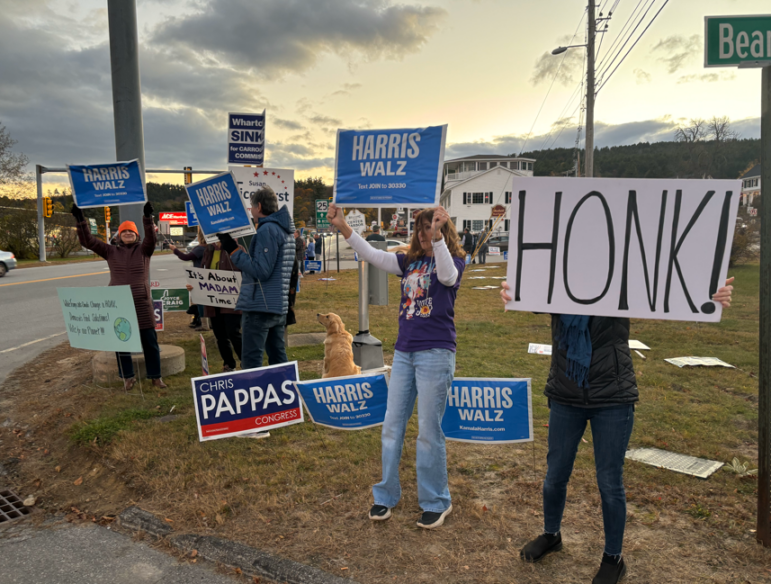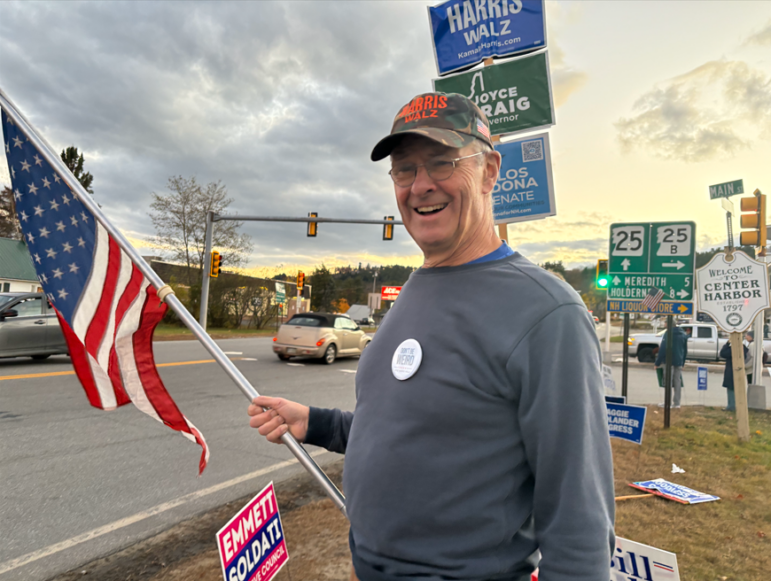
Honking in Center Harbor. Paula Tracy photo

Bob LaFlamme of Moultonborough holds the American flag while supporting Democratic candidates on Route 25 in Center Harbor Friday night. Paula Tracy photo
By PAULA TRACY, InDepthNH.org
PLYMOUTH – For more than a year, a group of supporters of former President and Republican Presidential nominee Donald Trump have gathered every Saturday morning on Tenney Mountain Highway near its intersection with Highland Street, to wave the American flag, engage with motorists and to support their candidate for President.
This Saturday morning was no different, but bigger and one person dressed as a Patriot, perhaps a left over from Halloween. The pick-up trucks were pulled up with the tailgate down as a place to sit, and supporters had their candidate at a rally blasting his views from a microphone for all those who were at the traffic lights to enjoy.
They would get the routine “honk” and wave.
This is a scene playing out for the next few days across the Granite State as an energized and politically connected electorate tries to get their message out in groups.
“Not only does visibility matter to politics, but it is an increasingly intrinsic constituent element and a crucial asset of it. Accordingly, the challenge to social science is that of understanding how the new institutional, urban, and technological settings are reshaping the organization of the visible,” according to a new book “The New Politics of Visibility” by Andrea Mubi Brighenti and published by The University of Chicago Press.
The book explores this phenomena with the engagement of groups who gather and their interactions with the driving public but underscores the importance of social connections, be it so basic as the honk of a horn.
In Center Harbor, Friday evening a group of more than 30 Democratic supporters, stood at the stop lights near E.M. Heath’s grocery store to hold their hand made signs, some with their dogs in tow wearing “Harris for President” signs.
Some like Bob LaFlamme of Moultonborough who was
willing to hoist the American flag and wave it proudly, as motorists honked.
The flag is not just a symbol for the Republicans, supporters noted.
Some in cars rolled their windows down to shout in opposition, others just put a thumbs down as they encountered the group, but many honked and waved. There was no doubt that what is known as political “visibility” is alive and well and a thing as voters are engaged up and down the ballot for Tuesday’s General Election.
Secretary of State Dave Scanlan said he is expecting a record turnout and noted one in 10 voters will likely be registering to vote on the same day as the Nov. 5 election.
An engaged electorate is part of New Hampshire culture and fiber of being, Scanlan said and noted that the state has historically among the highest turnout rates in the nation. He expects nothing different on Tuesday.
Sometimes visibility is organized. Sometimes it’s impromptu. But gatherings for visibility are found at many large intersections across the state, where vehicles idle and where political signs have been placed.
In the book about the new politics of visibility, it includes input from distinguished scholars and researchers and comprises “nine original interdisciplinary chapters that analyze topical areas in the newly emerging modes of governance and society. The transformations of urban space and the working of new media form a core concern recurring through many of the essays but is by no means the sole topic, as other essays address the politics of visibility in crucial cultural spheres, including gender relations and professional life.”
For those at both the Plymouth and Center Harbor locations, the experience people said allows them to engage with the public at a social distance and still get out their message.
While there were, in both cases, people who did not support the views expressed by the group, the lines of demarcation are often on either side of the road between parties in locations, for example like Concord’s Main Street where the countering of views is on full display and likely will be through voting, Tuesday when finally, the voters get to weigh in on all this.





